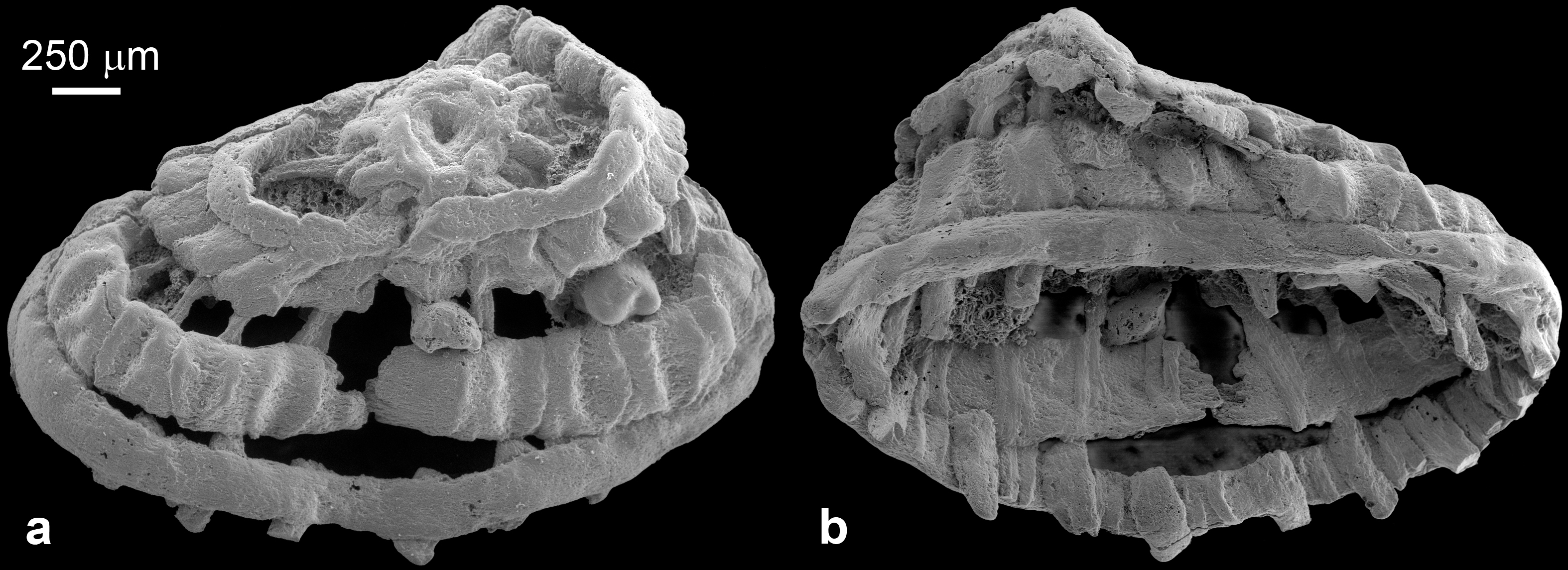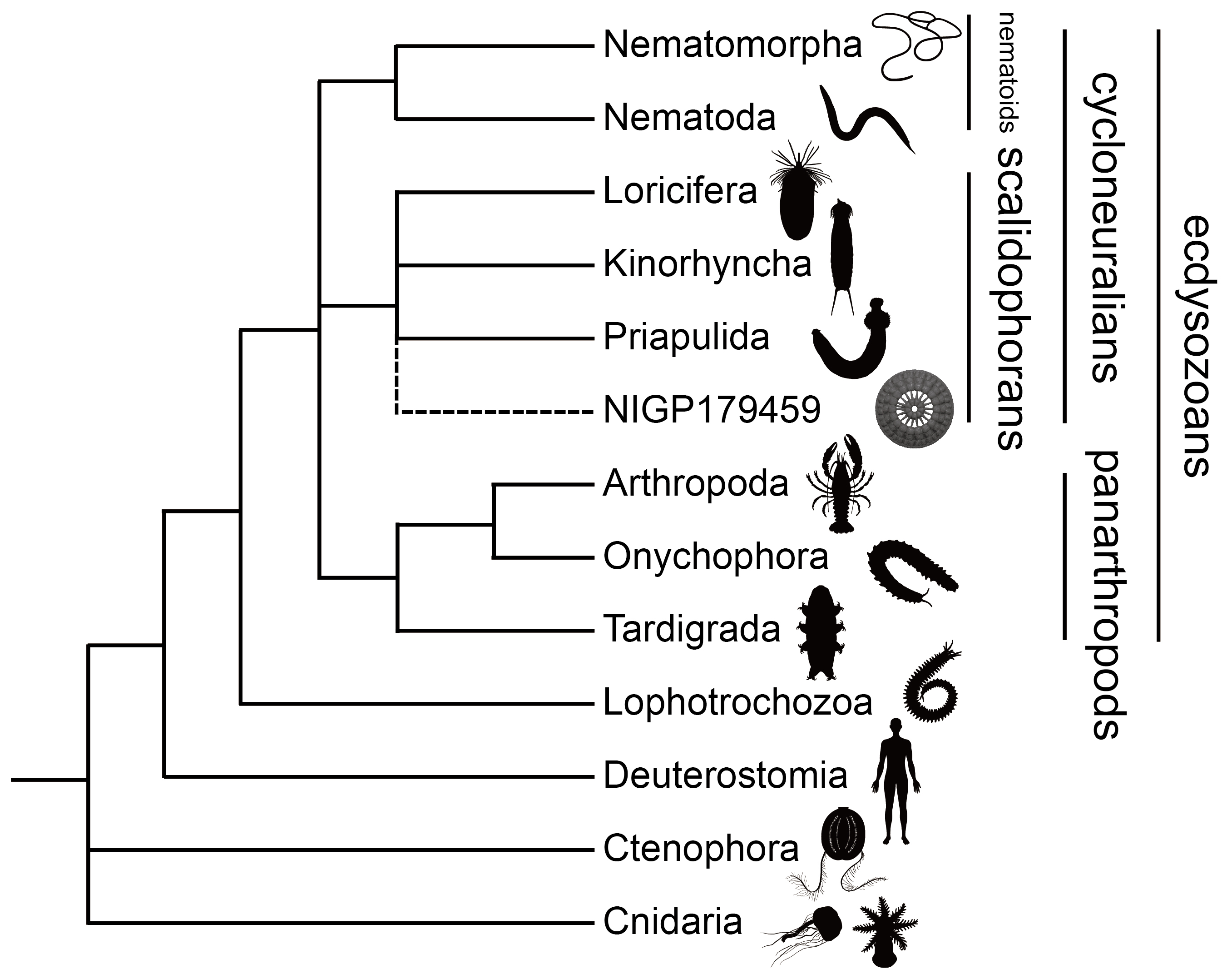
An international research team led by Prof. ZHANG Huaqiao from the Nanjing Institute of Geology and Palaeontology of the Chinese Academy of Sciences (NIGPAS) has reported the discovery of extraordinary early Cambrian (ca. 535 million years ago, or Ma) microfossils preserving the introvert musculature of cycloneuralians, a group of animals that include roundworms, horsehair worms, mud dragons, and many other creatures.
The discovery added fleshy insights into early Cambrian cycloneuralians, which are closely related to arthropods, the most successful animals on Earth.
The study was published in Proceedings of the Royal Society B: Biological Sciences on Oct. 11.
The Ecdysozoa superphylum represents the most diverse bilaterally symmetric animals. It contains Scalidophora (Kinorhyncha, Loricifera, Priapulida), Nematoida (Nematoda, Nematomorpha), and Panarthropoda (Tardigrada, Onychophora, Arthropoda). Scalidophora and Nematoida constitute the Cycloneuralia, whose monophyly is debated.
Unambiguous ecdysozoan body fossils first appeared in the early Fortunian Age (ca. 535 Ma) and are represented by the total-group ecdysozoan taxon Saccorhytus and several crown-group cycloneuralian species. However, the preservation of Fortunian ecdysozoans is limited to cuticular integuments, with no labile internal tissues (e.g., muscles or nerve tissues) preserved, hampering further understanding of their functional morphology and evolutionary significance.
In this study, the researchers described three phosphatized and millimeter-sized specimens from the early Fortunian Kuanchuanpu Formation (ca. 535 Ma) of China. Among them, one specimen (NIGP179459) is better preserved and consists of five successively larger rings that are interconnected with 19 radial and 36 longitudinal structures. The rings were compressed to certain degrees, implying that they were pliable when alive.
The first ring is separated from the remaining four larger rings by a gap and is located almost co-planarly at the center of, or slightly apical to, the second ring. The radial structures connect the first ring with the third ring, whereas the longitudinal structures extend from the third ring to beyond the fifth ring. Some longitudinal structures become more fibrous in textural appearance toward the abapical end. In the reconstruction, the second to fifth rings are coaxially stacked and constitute an apically truncated cone, with hexaradially arranged internal longitudinal structures.
Based on their patterns of arrangement, the fibrous texture, and the inferred pliability, the rings as well as the radial and longitudinal structures were interpreted as fossilized muscles. The preserved musculature consists of four groups of muscles, i.e., an inner circular, four outer circular, 19 radial, and 36 longitudinal muscles. This complex topology differs from that of the body-wall musculatures of basal animals such as cnidarians or ctenophores, and instead it likely represents musculature of bilaterian animals.
The hexaradial symmetry imparted by the arrangement of the longitudinal muscles invites a comparison with scalidophorans, whose introvert exhibits radial symmetry both externally (i.e., longitudinal rows of scalids are radially disposed) and internally (i.e., longitudinal muscles are radially arranged). With a scalidophoran affinity, the researchers interpreted specimen NIGP179459 as the anterior introvert musculature. The authors interpreted the second to fifth rings as body-wall circular muscles, and the 36 longitudinal structures as body-wall longitudinal muscles. The body-wall circular and longitudinal muscles constitute a muscular grid. Since a similar body-wall muscular grid is present in priapulans but absent in loriciferans and kinorhynchs, specimen NIGP179459 was proposed to belong to the priapulans. Considering that the priapulan-like introvert may have characterized the last common ancestor of the Scalidophora, it is also possible that specimen NIGP179459 belongs to total-group Scalidophora.
The total-group scalidophoran affinity of NIGP179459 is further supported by the first ring and radial structures. The researchers interpreted the first ring as an introvert circular muscle and the 19 radial structures as introvert circular muscle retractors. An introvert circular muscle is present in loriciferans, kinorhynchs, and the hatching larvae of priapulans, whereas introvert circular muscle retractors are present in kinorhynchs and the hatching larvae of priapulans. Furthermore, specimen NIGP179459 lacks a mouth cone and scalid-associated muscles, but these muscles are common in loriciferans and kinorhynchs. Thus, the total evidence supports a total-group scalidophoran affinity, possibly related to the priapulans.
Scalidophorans as represented by specimen NIGP179459 were millimeter-sized and had an introvert with hexaradially arranged scalids, which correspond to the hexaradially arranged body-wall longitudinal muscle bundles inside. This musculature may have controlled the inversion of the introvert and thus facilitated locomotion and feeding. The absence of long introvert retractors indicates that the animals may have had very limited ability to retract their introvert, differing from modern scalidophorans that have long introvert retractors and thus can completely retract their introvert.

Fig. 1 Reconstructions of NIGP179459 (Image by ZHANG Huaqiao)

Fig. 2 SEM images of NIGP179459 (Image by ZHANG Huaqiao)

Fig. 3 Schematic representation of scalidophoran musculatures (Image by ZHANG Huaqiao)

Fig. 4 Phylogenetic position of scalidophorans represented by NIGP179459 (Image by ZHANG Huaqiao)

86-10-68597521 (day)
86-10-68597289 (night)

52 Sanlihe Rd., Xicheng District,
Beijing, China (100864)

